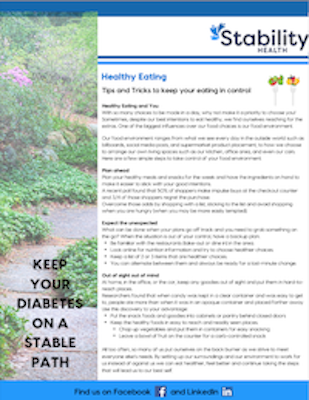
Tips and Tricks to keep your eating in control
Why does this matter to me?
With so many choices to be made in a day, why not make it a priority to choose you! Sometimes, despite our best intentions to eat healthy, we find ourselves reaching for the extras. One of the biggest influences over our food choices is our food environment.
Our food environment ranges from what we see every day in the outside world such as billboards, social media posts, and supermarket product placement, to how we choose to arrange our own living spaces such as our kitchen, office area, and even our cars. Here are a few simple steps to take control of your food environment.
Plan ahead
Plan your healthy meals and snacks for the week and have the ingredients on hand to make it easier to stick with your good intentions.
A recent poll found that 50% of shoppers make impulse buys at the checkout counter and 3/4 of those shoppers regret the purchase.
Overcome those odds by shopping with a list, sticking to the list and avoid shopping when you are hungry (when you may be more easily tempted).
Expect the unexpected
What can be done when your plans go off track and you need to grab something on the go? When the situation is out of your control, have a backup plan.
- Be familiar with the restaurants (take-out or dine in) in the area.
- Look online for nutrition information and try to choose healthier choices.
- Keep a list of 2 or 3 items that are healthier choices.
- You can alternate between them and always be ready for a last-minute change.
Out of sight out of mind
At home, in the office, or the car, keep any goodies out of sight and put them in hard-to- reach places.
Researchers found that when candy was kept in a clear container and was easy to get to, people ate more than when it was in an opaque container and placed farther away. Use this discovery to your advantage:
- Put the snack foods and goodies into cabinets or pantry behind closed doors
- Keep the healthy foods in easy to reach and readily seen places.
- Chop up vegetables and put them in containers for easy snacking
- Leave a bowl of fruit on the counter for a carb-controlled snack
All too often, so many of us put ourselves on the back burner as we strive to meet everyone else’s needs. By setting up our surroundings and our environment to work for us instead of against us we can eat healthier, feel better and continue taking the steps that will lead us to our best self.
Healthy Coping
Diabetes Distress is real and can make managing your diabetes a challenge
What is diabetes distress?
Diabetes distress is the emotional impact that diabetes can have on an individual and their loved ones. It can often be confused with depression or anxiety. Acknowledging this and seeking help from your support system and/or licensed professionals can improve your outcomes, both mentally and physically.
How do I know if I have diabetes distress?
If you feel overwhelmed living with diabetes or feel that you are not keeping up with your diabetes routine, then you may have diabetes distress. We recommend taking a quick test to check: Click on Diabetes Distress Survey and follow the instructions based on which type of diabetes you have.
I have taken the survey, what do my results mean? How can the survey results help me?
After completing the survey, your results are viewed in a bar graph which lets you know if you are currently experiencing High, Moderate or Low levels of diabetes distress. If you have type 1 diabetes, there are 7 areas of diabetes distress. If you have type 2 diabetes, there are 4 main areas of diabetes distress.
Identifying the areas in which you experience diabetes distress enables you to identify solutions that will help to improve your diabetes distress. Solutions to the issue(s) could be as easy as talking to your diabetes health coach about cost savings options, looking into diabetes support groups, speaking with your health care provider about your concerns, or utilizing resources to improve your overall distress.
Resources to check out:
Find a diabetes support group near you
The Center for Disease Control and Prevention’s tips for coping with diabetes distress.
